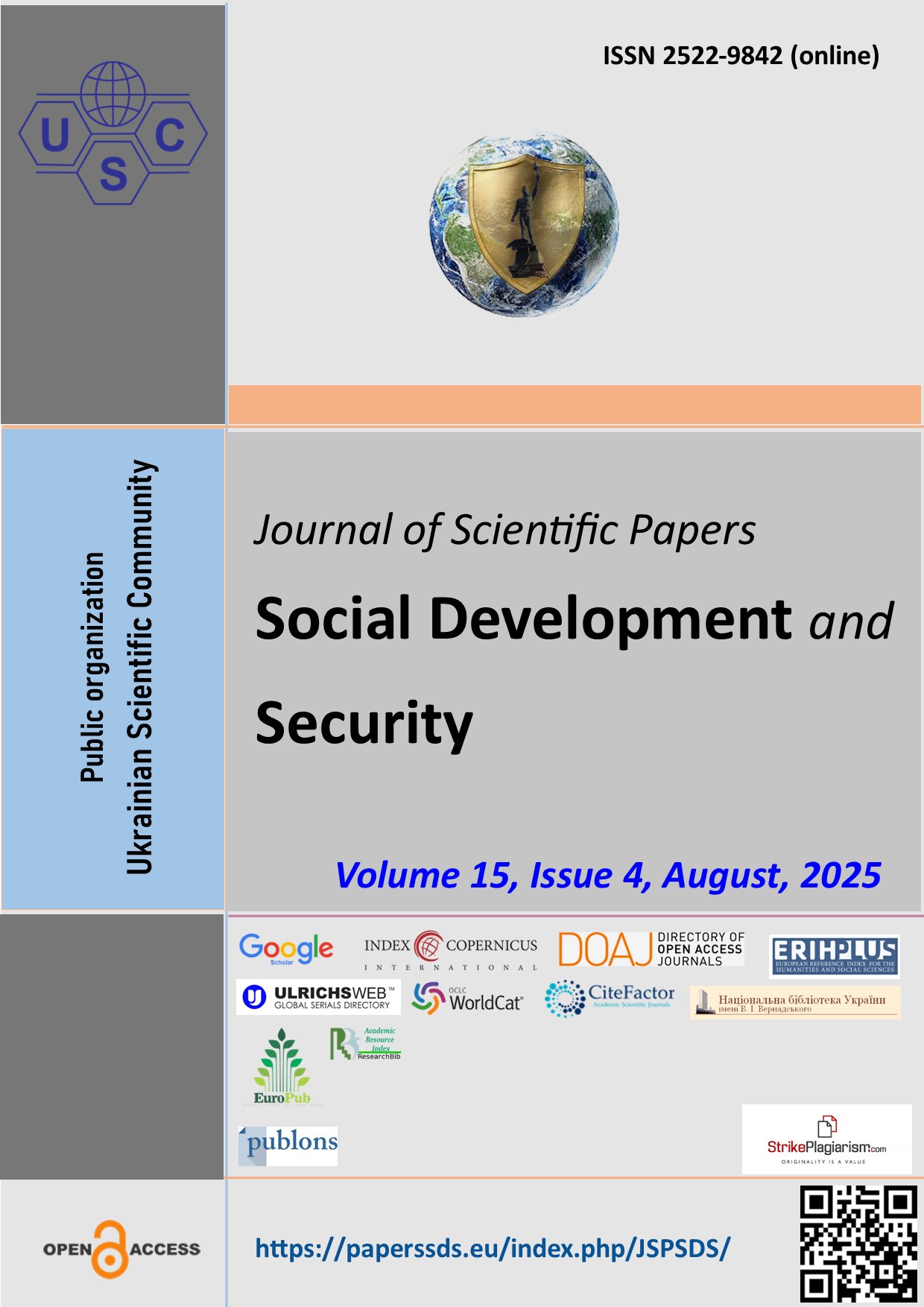The The Features of Students’ Awareness of Modern Road Safety Issues
Abstract
Purpose. To assess the level of students’ awareness of risky pedestrian behaviours, their attitudes towards road safety improvement measures, and their subjective perception of the safety of different modes of movement.
Method. A quantitative method of online surveying (Google Forms) was used in the study. A total of 410 students aged 16–23 from Ukraine (the city of Lviv) participated in the survey. An adapted ESRA 2 questionnaire was used, which included sociodemographic questions, an assessment of self-reported pedestrian behaviour, and perceptions of transport safety.
Findings. It was found that the most common types of risky behavior were using a mobile phone, crossing the road outside of a pedestrian crossing, and listening to music while walking (95%, 86%, and 75%, respectively). Students subjectively consider private cars to be the safest mode of transportation, although statistically, it is the most dangerous. Support for safety measures is higher for physical protective equipment (helmets, reflective clothing) than for restrictions on smartphone use. Gender and place of residence significantly influence pedestrian behavior.
Theoretical implications. The results confirm and extend existing concepts regarding the influence of cognitive and social factors on risky pedestrian behaviour. The study demonstrates the significance of digital distractions as an independent predictor of unsafe behaviour.
Practical implications. The obtained data can be used to develop educational programs in higher education institutions aimed at increasing students’ awareness of actual risks and effective safety measures. In addition, the results can serve as a basis for targeted social campaigns and for shaping public policy on the prevention of road traffic accidents.
Originality/Value. The paper offers a comprehensive analysis of self-declared pedestrian behavior among Ukrainian students in the context of modern digital culture, which has so far been virtually unexplored. Comparing the subjective assessment of transport safety with actual road traffic accident statistics makes it possible to identify significant cognitive distortions in risk perception.
Research limitations/Future research. The limitations of the study include the geographical sample (Lviv) and the self-declarative nature of the data, which may be accompanied by socially desirable responses. Promising directions for further research include experimental observations of actual pedestrian behavior, as well as expanding the sample to other regions of Ukraine and comparing different age groups.
Downloads
References
ESRA. (2018). E-Survey of Road users’ Attitudes. ESRA2. Available from : https://www.esranet.eu/en/about-the-project/esra2/
Krishna, K. V., Kapruwan, R., & Choudhary, P. (2024). Understanding distracted pedestrians’ risky behaviour: The role of walking and visual characteristics through a field study. Transportation Research Part F: Traffic Psychology and Behaviour, 101, 111–129. https://doi.org/10.1016/j.trf.2024.01.003
Nikolaou, D., Ntontis, A., Michelaraki, E., Ziakopoulos, A., & Yannis, G. (2023). Pedestrian safety attitudes and self-declared behaviour in Greece. IATSS Research, 47(1), 14–24.
Patrol Police. (2024). Statistics. Available from : https://patrolpolice.gov.ua/statystyka/
Saxena, A. (2023). Texting and crossing: An extended theory of planned behaviour to model the psychological and demographic factors related to pedestrians’ use of cell phone for texting at crosswalks in developing country. IATSS Research, 47(1), 50–60. https://doi.org/10.1016/j.iatssr.2023.01.003
Sheykhfard, A., Haghighi, F., Kavianpour, Sh., Das, S., Farahani, P. S., & Fountas, G. (2023). Risk assessment of pedestrian red-light violation behavior using surrogate safety measures: Influence of human, road, vehicle, and environmental factors. IATSS Research, 47(4), 514–525. https://doi.org/10.1016/j.iatssr.2023.11.003
Torfs, K., & Meesmann, U. (2019). How do vulnerable road users look at road safety? International comparison based on ESRA data from 25 countries. Transportation Research Part F: Traffic Psychology and Behaviour, 63, 144–152. https://doi.org/10.1016/j.trf.2019.04.001
Wang, Ch., Hou, M., Easa, S. M., & Cheng, J. (2024). Safety analysis of pedestrians distracted by mobile phones at street crossings: Field study in Nanjing. Accident Analysis & Prevention, 200, Article 107563. https://doi.org/10.1016/j.aap.2024.107563
Wang, H., Wang, A., Su, F., & Schwebel, D. C. (2022). The effect of age and sensation seeking on pedestrian crossing safety in a virtual reality street. Transportation Research Part F: Traffic Psychology and Behaviour, 88, 99–110. https://doi.org/10.1016/j.trf.2022.05.010
World Bank. (2019). Road traffic death rate (per 100,000 population). Available from : https://data.worldbank.org/indicator/SH.STA.TRAF.P5?end=2019&start=2019&view=map
World Health Organization. (2023). Global status report on road safety 2023. Available from : https://www.who.int/publications/i/item/9789240086517
Abstract views: 78 PDF Downloads: 21
Copyright (c) 2025 Solomiya Pysarevska, Viktoriya Vashchuk, Zinoviy Yaremko

This work is licensed under a Creative Commons Attribution 4.0 International License.
The authors agree with the following conditions:
1. Authors retain copyright and grant the journal right of first publication (Download agreement) with the work simultaneously licensed under a Creative Commons Attribution License that allows others to share the work with an acknowledgment of the work's authorship and initial publication in this journal.
2. Authors have the right to complete individual additional agreements for the non-exclusive spreading of the journal’s published version of the work (for example, to post work in the electronic repository of the institution or to publish it as part of a monograph), with the reference to the first publication of the work in this journal.
3. Journal’s politics allows and encourages the placement on the Internet (for example, in the repositories of institutions, personal websites, SSRN, ResearchGate, MPRA, SSOAR, etc.) manuscript of the work by the authors, before and during the process of viewing it by this journal, because it can lead to a productive research discussion and positively affect the efficiency and dynamics of citing the published work (see The Effect of Open Access).
















